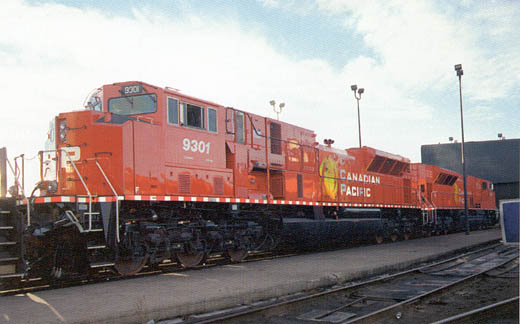 |
Fall/Winter 2006
|
Bigger is Not Always Better
Part #2, The Diesel
Era
STEEL
WHEELS by Corporate Historian Emeritus Jonathan Hanna

Big MACs have been giving the
railway's mechanical department a case of indigestion.
CPR has bought or built some pretty big
brutes in the past... big, brutish locomotives, that is. But, as we saw last time with multi-pressure
steam locomotive No. 8000, bigger hasn't always been better.
The latest big brutes on the property are the four 6,000-h.p. SD90MAC locomotives CPR got from General
Motors at the tail end of 1999. CPR originally was going to get 20 of these high-horsepower
locomotives. But it decided to try out four of them first and put the other 16 on hold. And good thing, too. The
four, numbered 9300-9303, are big, brawny, and brutish, but they've also had a bunch of breakdowns.
You'd think we'd have learned our bigger-is-not-always-better lesson by now. In the Great Depression,
multi-pressure steam locomotive No. 8000 taught CPR a fussy and expensive lesson in fuel and water
consumption reduction. CPR also learned a lot from its first and second-generation
bigger-and-better diesel-electric locomotive purchases.
In the mid-1950s CPR bought 21 "Train Master" locomotives powered by 2,400-h.p.
submarine-type engines. At the time, these were the biggest and most powerful CPR
diesel-electric locomotives ever. But not a single one made it to its 21st birthday.
By the late 1960s, CPR loaded up with high-horsepower, second-generation
3,000-h.p.-or-better main line locomotives. But the motive power mandarins in Montreal were titillated
by a totally awesome Montreal Locomotive Works prototype that boasted 4,000 horsepower. Men are men, and the
male-dominated motive power department just couldn't pass up the monstrous machine. So CPR took
delivery of No. 4744 - the one-and-only-ever 4,000-h.p., 18-cylinder
M-640 locomotive.
When the prototype arrived on the property, in March 1971, it was the biggest and most powerful CPR
diesel-electric locomotive yet. Only thing is... it didn't deliver on the promise. It had to be
de-rated up to 1,000-h.p. less until CPR decided to try something new and ingenious with
it. In 1984, CPR converted the locomotive to North America's first AC-traction locomotive. And, in the
bargain, it got the horsepower back up to 4,000.
Scroll ahead to the end of the millennium. General Motors' big and bold 6,000-h.p. SD90MAC was the bait
this time. And CPR bit. But we didn't go for the hook, line, and sinker too.
The diesel decision makers were rightfully cautious this time. Instead of going for the entire order of 20
locomotives, as was planned, the order was pared back to four. And, at $4 million a pop, that was plenty.
The mechanical department wanted to see how things went first. And things haven't gone so well since the
get-go.
So far, CP 9300 to 9303 have spent a lot of their six-year life in the shop. They are back in service
now after a six-month Winnipeg mechanical shop layover. The 6,000-h.p.
heavy-haulers pull the lighter transcontinental finished goods and container trains.
| |
Vital
Statistics
|
Locomotive Numbers
|
9300-9303
|
Class
|
DRF-60a
|
Builder
|
General Motors
|
Outshopped
|
December 1999
|
Builder's Model
|
SD90MAC
|
Horsepower
|
6,000
|
No. of Cylinders
|
12
|
No. of Axles
|
6
|
Maximum Speed
|
120 km/h (75 mph)
|
Extreme Length
|
24.4 metres (80 ft. 2 in.)
|
Extreme Width
|
3.2 metres (10 ft. 6 in.)
|
Extreme Height
|
4.8 metres (15 ft. 10 in.)
|
Weight (Loaded)
|
192,780 kg (425,000 lbs.)
|
Purchase Price
|
$4,008,954
|
This Canadian Pacific Spanner article
is copyright 2006 by the Canadian Pacific Railway and is reprinted here with their
permission. All photographs, logos, and trademarks are the property of the Canadian Pacific Railway
Company.
|